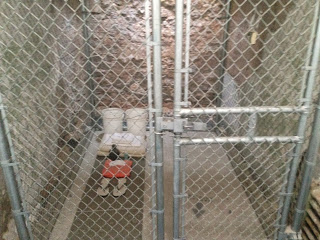Museum Practicum: Objection Blog: Eastern State Penitentiary
Oktavia LaBarge, September, 12, 2013
Title: GTMO
Year: 2006-2013
Material: Chain link fence, rocks, cement, plastic canteen, white plastic five-gallon buckets, shoes, orange jumpsuit, foam mattress, sheet, blankets, washcloth, bar of soap, toothpaste, toothbrush, shampoo, towels, prayer cap, and the Holy Quran.
Creator: William Cromar
Collection: Eastern State Penitentiary: Artists Installation
Each year, Eastern State Penitentiary accepts artists proposals of possible installations. A committee reviews the different proposals and chooses a few to add to their collection. Currently, the historic site has 72 artist’s installations. These different installations invite artists to question controversial subjects through different mediums.
This is an installation called GTMO, by the artist, William Cromar. Made within a prison cell in the historic Eastern State Penitentiary. Cromar created this work as a commentary on the older cells used in Camp X-Ray at Guantanamo Bay. Guantanamo Bay is located in Cuba and is where “enemies” of the nation are currently held without being tried in the United States justice system. Before creating the actual detainment center the use of chain-linked fence kept the prisoners.
Placing this installation within Eastern State Penitentiary makes viewers question the rights of prisoners being held in Guantanamo Bay. GTMO is important for people who are unaware of the prisoners held without trial and makes them question why the government is holding these people prisoner. This installation is important to make people aware of issues that are going on around the world.
Cromar’s, GTMO was installed within one of the cells in Cellblock 13 in the ruins of Eastern State Penitentiary. The viewer is invited to step from the hallway into the prisoner’s cell to view a large square chain-link fence with a concrete floor. The ground the viewer stands on is composed of small rocks. On the ground inside the chain-linked fence is a small foam mattress and on the mattress sits folded blankets, sheets, an orange jumpsuit, a washcloth, and two towels. Next to these folded objects is one plastic canteen, two five-galloon buckets, one bar of soap, one tube of toothpaste, one toothbrush, one bottle of shampoo, one prayer cap, and a copy of the Holy Quran. In the Muslim religion the Holy Quran is not supposed to touch the ground, so it is suspended by a surgical mask. On the floor of the chain-linked cell is a stenciled arrow which points to the Kaaba in Mecca, it is used for daily prayer. Viewers are not allowed access to enter the chain-linked fence, so one can only view it from the outside.
Outside in the hallway are two labels on either side of the doorway posted near the cell. To the right of the cell is a description of what is inside the cell. On the left side of the cell is a description of the installation.
In addition, to the two text labels visitors of the museum are given an audio tour. To learn about this installation, the visitors must type the audio number, 48, and will be able to hear the artist speak. The labels and audio reveal the point of view of the artist who disagrees with the use of Guantanamo Bay and the holding of prisoners who have not been tried in our judicial system. It is clear the artist is using the labels and the audio to inform the viewers of what is occurring and tries to persuade the viewers to agree with the point of view in order to take action.
Creating an installation of a cell used in Guantanamo Bay within a cell in an old jail creates a deeper meaning of imprisonment. Having a cell within a cell, makes viewers compare the two very different types of detainment. The inside cell that resembles the Camp X-Ray cells reminds the viewer of a dog cage, as well as, reminds the viewer that the people of Guantanamo Bay have been stripped of their basic human rights and are being treated like an animal. To further understand this installation, one might consider researching Guantanamo Bay and learning the history of the detainment center.
This installation by Cromar is very controversial and many visitors to Eastern State Penitentiary may not be interested in this topic. Supporters of Guantanamo Bay and people who serve in the armed forces, may be upset by the very obvious statement that Cromar is presenting. In addition, people who have served in the armed forces may not feel compassion for the people who are placed in these cells because they may have a very different point of view about these detainees. However, the purpose of the installation is to create a reaction and a deeper discussion, so having a negative reaction to the installation is acceptable.
There are many different ways that the artist could expand this experience that would engage viewers. For example, Cromar could have placed a similar chain-linked cell in multiple cells or in multiple different cellblocks. In addition, the artist could have added images of people who are detained in these types of cells or at Guantanamo Bay to further personalize the exhibit. Cromar could also have testimonies of prisoners or guards at Guantanamo Bay to evoke more of a response.




No comments:
Post a Comment